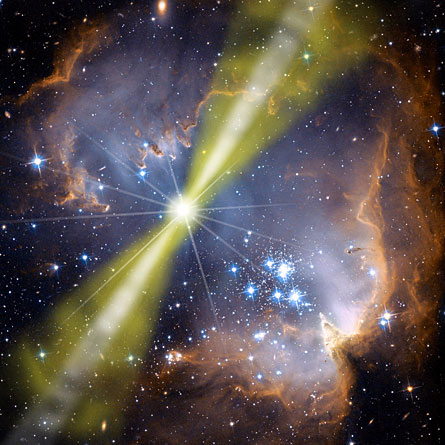For 40 seconds on March 13, a pinpoint of light suddenly appeared in the constellation Bootes, shining more brightly then 10 million galaxies. The radiation accompanied a powerful stellar explosion halfway across the universe and set two records: It was the most distant naked-eye object ever recorded from Earth and the most luminous.
Astronomers have studied in detail hundreds of these stellar explosions, known as gamma-ray bursts, and most lie even farther from Earth. But researchers had particular good fortune in observing the March 13 burst, dubbed GRB 080319B, because they were already tracking another burst that had erupted less than 30 minutes earlier in a nearby region of the sky. So they were able to view the new outburst in record time after NASA’s Swift satellite observed its gamma rays.

In the Sept. 11 Nature, the team reports that the visible-light emission from this gamma-ray burst is 100 times brighter than the previous record holder.
“The combination of these unique optical data with simultaneous gamma-ray observations provides powerful diagnostics of the detailed physics of this explosion within seconds of its formation,” Judith L. Racusin of PennsylvaniaStateUniversity in University Park and her colleagues note in an article posted online on arXiv.org.
Another piece of luck also played a role in discovering the brilliant visible-light emission from this gamma-ray burst. “We deduce that we happened to view this monster down the barrel of this very narrow and energetic jet” aimed directly at Earth, Racusin and colleagues reported on arXiv.org .
If all gamma-ray bursts have such narrow jets and are only detected when a jet points in the general direction of Earth, the total number of bursts could be 10 to 100 times more common than previously thought, says Josh Grindlay of the Harvard-Smithsonian Center for Astrophysics in Cambridge, Mass, in a commentary accompanying the Sept. 11 Nature report.
Three different components contributed to the visible-light emission, from the first seconds after the burst to hours and days afterward, says coauthor Enrico Ramirez-Ruiz of the University of California, Santa Cruz. Researchers have never before seen all three components in a single burst, he says.
“It confirms a lot of the standard model, but more importantly, it also shows the complexity of the processes,” Ramirez-Ruiz adds.
According to that model, a burst occurs when a jet of material breeches the surface of a massive star and zooms far beyond it. Collisions between blobs of material within the jet produce the gamma rays. The data collected on GRB 080319B strongly suggest that the earliest visible-light photons from the burst, produced during the first 50 seconds, are also generated within the jet but by a different process.
The second component, which endures from 50 seconds post-explosion to 800 seconds, shows characteristics of what astronomers call a reverse shock. This occurs when the high-speed jet encounters surrounding interstellar material; that material sends a shock into the slowed jet. The final component, after 800 seconds has elapsed, is the familiar visible-light afterglow of a gamma-ray burst, generated by the forward shock created when the jet slams into gas and dust in the surrounding space.
The initial avalanche of visible-light radiation, known as prompt optical emission, is most likely produced by fast electrons gyrating around strong magnetic fields within the jet, the researchers suggest. In contrast, the gamma rays, which have much higher energies, may be generated by collisions between some of the visible-light photons and the fast electrons, which kick these photons up to gamma-ray energies.
In order for astronomers to see the initial visible-light emission, the jet from the exploding star must have been traveling at 0.999998 the speed of light, Ramirez-Ruiz calculates. Such a jet quickly leaves the exploding star far behind and enters a low-density region where visible-light photons can easily escape the jet rather than undergo repeated collisions with the jet’s electrons. A high-speed jet is also narrowly focused, and the researches suggest that this burst is a rare example of a highly concentrated outburst that by luck happened to be aimed directly toward Earth.
The brilliance of the visible-light emission gives researchers new hope that even more distant bursts could be used to probe some of the earliest epochs of the universe, a time before the first stars were born, says Josh Bloom of the University of California, Berkeley. He and his colleagues posted their observations of the burst online in March and will also report their findings in an upcoming Astrophysical Journal.
The brightness of the burst “really crowns these as kings for the next few decades” for probing the early universe, Bloom adds.
These new studies, comments theorist Andrew MacFadyen of New YorkUniversity, “are telling us what the jet structure is, and that’s very useful for constraining models of the explosion.”







